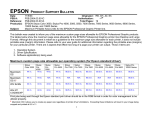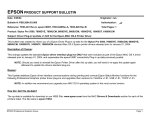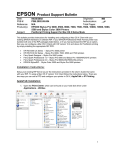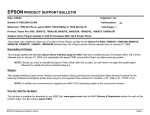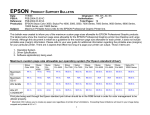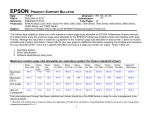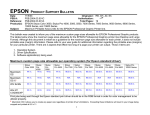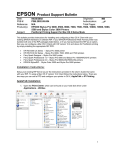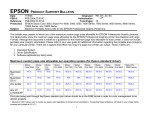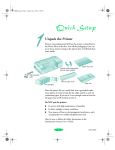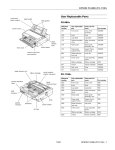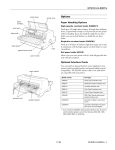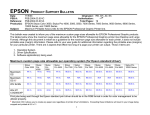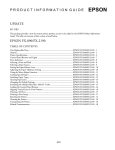Download Epson Stylus Pro 10000 Print Engine with Archival Ink Product Support Bulletin
Transcript
EPSON PRODUCT SUPPORT BULLETIN Date: 3/25/04 Originator: rws Bulletin #: PSB.2004.03.006 Authorization: Reference: TE03-461 Rev.A, epson10997, TE03-620Rev.A, TE03-620 Rev.B Total Pages: 1 Product: Stylus Pro 5500, 7600DYE, 7600UCM, 9600DYE, 9600UCM, 10000DYE, 10000CF, 10600UCM Subject: Driver Plug-in Up-Date v1.0cE for the Epson MAC OS-X Printer Driver This bulletin was created to inform you of a Epson Driver Plug-in up-date for the Stylus Pro 5500, 7600DYE, 7600UCM, 9600DYE, 9600UCM, 10000DYE, 10000CF, 10600UCM standard Mac OS X Epson printer drivers released prior to January 01, 2004. Description of Change: This change updates the standard Epson driver interface plug-ins ONLY that were included as part of the Epson MAC OS X driver released prior to January 01, 2004, and supersedes the epson10997 connectivity Plug-in up-date previously posted. NOTE: Should you need to reinstall the Epson Printer Driver after this up-date, you will need to re-apply the update again afterward to update the drivers standard plug-ins. Reason: This Update stabilizes Epson driver Interface communications during printing and corrects Epson Status Monitor functions for the following Professional Graphics printer driver plug-ins and upgrades their versions to: FireWire v1.81, USB v1.81, TCPIP v1.81. NOTE: In addition we recommend you upgrade your MAC OS-X operating system to the most current version. How Do I Get The Up-Date? The up-date is available for download on our WEB SIte: www.epson.com from the MAC Drivers & Downloads section for each of the printers listed. The file name is epson11054. EPSON Professional Graphics Group Page 1. EPSON Date: PSB #: Reference: Product(s): Subject: PRODUCT SUPPORT BULLETIN 11/8/04 Originator: RB, CH, JD, SA PSB.2004.03.001C Authorization: PSB.2004.03.001A Total Pages: 19 EPSON Stylus Color 3000, Stylus Pro 4000, 5000, 5500, 7000 Series, 7600 Series, 9000 Series, 9600 Series, 10000 Series, and 10600 Series Maximum Printable Area Limits for the EPSON Professional Graphic Printer line. This bulletin was created to inform you of the maximum custom page sizes allowable for EPSON Professional Graphic products. The tables below show the maximum page sizes allowable for the EPSON Professional Graphics printer line (Desktop and Large Format). Although this document is meant as a guideline for the maximum page size allowable for each printer, it does not include printable area (margin) information. Please refer to your user guide for additional information regarding the printable area (margins) for your particular printer. There are 3 aspects that effect how long of a page your printer can output. Those 3 items are: 1. Operating System. 2. Driver Specification. 3. Software application(s) being used. Maximum custom page size allowable per operating system (for Epson standard driver): Stylus Color 3000 Macintosh OS 44 in. Stylus Pro 4000 44 in. Macintosh OS X* 44 in. 44 in. N/A 44 in. N/A N/A 90.5 in. N/A N/A 90.5 in. 90.5 in. Win 9x/Me 44 in. 44 in. 44 in. 44 in. 90.5 in. 90.5 in. 90.5 in. 90.5 in. 90.5 in. 90.5 in. 90.5 in. Win NT 4.0/2000/XP 44 in. 44 in. 44 in. 44 in. 90.5 in. 90.5 in. 90.5 in. 90.5 in. 90.5 in. 90.5 in. 90.5 in. Stylus Pro 5000 44 in. Stylus Pro 5500 Stylus Pro 7000 Stylus Pro 7500 Stylus Pro 7600 Stylus Pro 9000 Stylus Pro 9500 Stylus Pro 9600 Stylus Pro 10000 Series 44 in. 90.5 in. 90.5 in. 90.5 in. 90.5 in. 90.5 in. 90.5 in. 90.5 in. Print jobs being sent through the Epson standard print driver should be in the RGB format in order for color management to be utilized properly. * Macintosh OS X allows you to create any paper size regardless of printer driver’s limitations. cropped and printed at 8.5 x 11. 1 Exceeding these limitations will result in your image being Maximum custom page size allowable for EPSON PostScript options (PPD): Stylus Color 3000 EPSON Stylus RIP EPSON Fiery RIP Station EPSON Fiery Spark Designer (Mac) EPSON Fiery Spark Professional EPSON ColorBurst RIP Stylus Pro 4000 Stylus Pro 5000 Stylus Pro 5500 Stylus Pro 7000 Stylus Pro 7500 Stylus Pro 7600 Stylus Pro 9000 Stylus Pro 9500 Stylus Pro 9600 44 in. N/A 44 in. N/A N/A N/A N/A N/A N/A N/A Stylus Pro 10000 Series N/A N/A N/A 44 in. N/A See NOTE 1 See NOTE 1 N/A See NOTE 1 See NOTE 1 N/A N/A N/A N/A N/A 44 in. N/A N/A N/A N/A N/A N/A N/A N/A N/A N/A 44 in. N/A N/A See NOTE1 N/A N/A See NOTE1 See NOTE 1 N/A See NOTE1 N/A 44 in. N/A N/A See NOTE1 N/A N/A See NOTE1 See NOTE 1 Print jobs being sent through the Epson PostScript driver can be either RGB or CMYK format. Settings in the RIP will determine how color management is used. Maximum page size allowable from software applications: Adobe Photoshop 5.x/6.x/7.x/ Adobe Photoshop CS *Adobe Illustrator 8.x/9.x *Adobe Illustrator CS QuarkXPress 4.x/5.x/6 *CorelDRAW 8.x/9.x/10.x/11.x Stylus Color 3000 Stylus Pro 4000 Stylus Pro 5000 Stylus Pro 5500 Stylus Pro 7000 Stylus Pro 7500 Stylus Pro 7600 Stylus Pro 9000 Stylus Pro 9500 Stylus Pro 9600 See NOTE 2 See NOTE 2 See NOTE 2 See NOTE 2 See NOTE 2 See NOTE 2 See NOTE 2 See NOTE 2 See NOTE 2 See NOTE 2 Stylus Pro 10000 Series See NOTE 2 See NOTE 2 See NOTE 2 See NOTE 2 See NOTE 2 See NOTE 2 See NOTE 2 See NOTE 2 See NOTE 2 See NOTE 2 See NOTE 2 See NOTE 2 227 in. 227 in. 227 in. 227 in. 227 in. 227 in. 227 in. 227 in. 227 in. 227 in. 227 in. 227 in. 227 in. 227 in. 227 in. 227 in. 227 in. 227 in. 227 in. 227 in. 227 in. 227 in. 48 in. 48 in. 48 in. 48 in. 48 in. 48 in. 48 in. 48 in. 48 in. 48 in. 48 in. 1,800 in. 1,800 in. 1,800 in. 1,800 in. 1,800 in. 1,800 in. 1,800 in. 1,800 in. 1,800 in. 1,800 in. 1,800 in. 2 * These applications allow for tiling of print pages, therefore allowing you to print beyond the printers maximum page length limit and print to the applications limits. The printer driver must be set for Roll Paper (Banner) mode so that page breaks at the printer’s maximum page length do not occur (in essence gives you a 0 margin for the bottom of the page). The Stylus Pro 5000/5500 however will give a slight page break at the 44 inch limit as these printers do not support banner mode. Also, printing certain elements from these applications may not utilize color management correctly/properly and may produce output color that is not expected. NOTE 1: a. Under Win 9x/Me, the PPD limit is 129 inches. b. Under Windows NT, 2000 and XP, the PPD limit is 1771.6 inches (SP7000/9000 Series) and 1800 inches (SP7600/9600/10000 Series). c. Under Mac OSX/8.x/9.x, the PPD limit is 273.06 inches. NOTE 2: Adobe Photoshop has a pixel limitation of 30,000 pixels, which means that a document created @ 300ppi can only reach a maximum page size of 100 inches (H and V). When sending jobs to the printer via the standard nonPostScript print driver, Photoshop looks at the input resolution of the printer driver and adjusts the page size accordingly. All Epson large format printers use 360dpi as the input resolution (this is the resolution data is rasterized at), therefore when printing from Photoshop, the maximum page length you will be able to output to any Epson large format printer using the standard Epson print driver would be 83.33 inches (30,000 pixels / 360dpi). As for the Epson desktop products, they rasterize data at 720dpi, therefore the maximum page length obtainable with the standard print driver would be 41.67 inches (30,000 pixels / 720dpi). Also, under Photoshop 5.x/6.x for the Macintosh and Photoshop 6.x for the PC, the job will end up clipped if it is over the 83.3inch printer page limit. In Photoshop CS, the print job will end up clipped if it is over the 86inch printer page limit; however it will allow you to create a custom paper size of 91inches max. If you are using Photoshop 5.x for the PC, the print job will actually be truncated to fit within the printable area of the printer. Be advised that you may not get a page size error. It may be useful to enable the “print preview’ function of your printer driver (if available) so that you do not waste unnecessary media. The only options for printing beyond the limitations is to save the file and print via an application that does not have the 30,000 pixel limit (may lose color management functions) or print the file through a PostScript RIP (which will allow for longer pages). UPDATE: Photoshop CS allows for a maximum Pixel limit of 300,000 x 300,000 (this would create a 251.5 GB file!!) This allows Photoshop to have a print dimension of 4166.666 x 4166.666 at 72 ppi (Pixels per Inch). At 360 ppi, your max print size would be 833.333 x 833.333. You can still only print 44 x 90.5” Photoshop CS at this point exceeds the capability of our printers. 3 For Windows Users, if you encounter partial/incomeplete prints while having Finest Detail enabled, please disable this setting. It is recommended for low resolution text and line art to sharpen their edges. For photos, this may create a massive print file that is too large for the printer driver to process correctly. The following examples show how to setup banner printing from Adobe Illustrator 8.x/9.x and CorelDRAW 9 from the PC platform. The Macintosh versions of these applications should be very similar in function. Please refer to your software documentation for additional assistance. 4 Adobe Illustrator CS: In this example, we are creating a banner, which is 227 inches (Illustrators max. page setup). NOTE: Mac O/S 10.3.3 system is used in this example. Windows versions of this application should be very similar in functionality. Please refer to your software documentation for additional assistance. In this example, a “20 inches wide X 180 inches high” document is created. 1. Click on File and New, set up the width and height (sample shows 20 W x 180 H), then click OK. 2. Insert the image you want to print and stretch it until it covers the whole page. 5 3. Click on File, Print, click Setup, under Tiling click on the drop down arrow, select Tile Full 4. Pages and click the Printer button. 5. When the printer setup window comes up, select your printer name and set the Roll Paper Options to: Roll Paper Banner Roll Paper Banner – No Margin ( if printing no margins) 6. In the Copies and Pages section, click on the drop down arrow, select Roll Paper Option. Uncheck Auto Cut then check Save Roll Paper. 6 7. Then click on Print. This will bring you back to the Print window. 8. This time click on Page Setup, you see the following screen, just click on Continue (If you don’t want to see the window again, place a check mark on Don’t Show Again box). 7 9. When Page Setup is open, click on the down arrow for Custom Paper Size. NOTE: When creating the custom page size, divide the banner size by a value that will make it less than the printer maximum custom page size (90.5 inches). In this example we take (180/2 = 90), therefore the custom page size created would be 20x90 (inches). 10. Click on New, name the custom size (i.e. 20 x 180 in this example), under Paper Size type in 20 inches for the width and 90 inches for the height, margins should be set to zero (0). Click on Save. Click on the down arrow again in the Custom Paper Size and select Page Attributes. 8 11. Under Paper Size, click on the drop down arrow and select the custom paper size you created (i.e. 20 X 180) orientation is set to portrait mode. Then click OK. 12. In the Print windows the preview pane will show 2 grids or pages. This indicates that a full image is tiled. 9 13. Click on General, then click the square on Reverse Order. 4. Click on Print. 10 NOTE 1: When enabled, the first page will be printed first, instead of the last page first. Or Change the orientation to “Reverse”, then you don’t have to check the “Reverse Order”. NOTE 2: Always select the custom page size last, if not, it will default to other paper sizes. NOTE 3: Before printing a large document, make sure you have enough ink to prevent getting an Ink Out message, causing the print job to stop and not completing the entire print. 11 Adobe Illustrator 8.x/9.x: In this example, we are creating a banner, which is 227 inches (Illustrators max. page setup). 1. Launch Illustrator and open or place your file in the page layout. 2. Click on File, then Document Setup. The following screen appears. 3. Uncheck Use Print Setup, enable Tile Full Pages and create the page size (in our example we used 44x227 inches). 4. Click, Print Setup. This will bring up the print driver. 12 5. Click on the Paper Tab. The following appears. 6. Set the Paper Source to Roll Paper (Banner) and also enable Save Roll Paper. 7. When creating the custom page size, divide the banner size by a value that will make it less than the printer maximum custom page size. In this example we take (227/3 = 75.7), therefore the custom page size created would be 44x75.7 inches. The reason for this is to save media. 13 8. After setting the custom page size and other driver settings (media type, resolution, etc.), click OK. This will bring you back to the document setup. Now double-click the “Page” tool. 9. The page should now show the following. 10. At this point you can and resize the image to fit within the printable area and print. 14 CorelDRAW: In this example, a banner is created at 227 inches. 1. Launch CorelDRAW and open or place an image in your page layout. 2. Adjust the page size and image for the document as shown in the following image. 3. Click on File and Print Setup. 15 4. Click on the Paper Tab. The following appears. 5. Set the Paper Source to Roll Paper (Banner) and also enable Save Roll Paper. 16 6. When creating the custom page size, divide the banner size by a value that will make it less than the printer maximum custom page size. In this example we take (227/3 = 75.7), therefore the custom page size created would be 44x75.7 inches. The reason for this is to save media. 7. After setting the custom page size and other driver settings (media type, resolution, etc.), click OK. This will bring you back to the document. 17 8. At this point, click File then Print. CorelDRAW will then run a pre-flight check and will show the following window. 18 9. Click on the Layout Tab and enable Print Tiled Pages and set any additional parameters as you see fit. 10. At this point you could check other tab settings (if necessary) and click Print Preview (recommended) if you want to see how the file will be printed or Print to output the file to your printer. For all other applications, please refer to your software documentation for information on maximum custom page sizes for documents, banners or tiling prints. 19 EPSON PRODUCT SUPPORT BULLETIN Date: 1/23/04 Originator: rws Bulletin #: PSB.2004.01.001 Authorization: Reference: TE03-461 Rev.A Total Pages: 1 Product: Stylus Pro 5500, 7600DYE, 7600UCM, 9600DYE, 9600UCM, 10000DYE, 10000CF, 10600UCM Subject: Connectivity Plug-in Update v1.0bE for the Epson MAC OS X Printer Driver A connectivity plug-in update is available for the standard Epson MAC OS X printer drivers released prior to January 1, 2004. This update applies to these printers: Stylus Pro 5500, 7600DYE, 7600UCM, 9600DYE, 9600UCM, 10000DYE, 10000CF, 10600UCM Reason For Update: This update improves the stability of the drivers USB, Firewire and TCP/IP communication module plug-ins. Note: If you reinstall the Epson printer driver after you have updated the plug-ins, you must apply this plug-in update again, as reinstalling the driver overwrites and installs the older version plug-ins. The version of the updated plug-ins installed in the Epson Printers folder can be verified using Get Info: FireWire USB TCP/IP v1.72 v1.72 v1.75. Note: In addition we recommend that your MAC OS X operating system be at the most current version. How Do I Get The Update? The update is available for download from www.epson.com. Select Drivers & Downloads, select your printer model, scroll to Macintosh Operating Systems, and download the update (filename epson10997). EPSON Professional Graphics Group Page 1. EPSON PRODUCT SUPPORT BULLETIN Date: 07/03/03 Bulletin #: PSB.2003.05.001B Reference: NA Originator: rws Authorization: Total Pages: 12 Product: Stylus Pro 7600/9600/10000/10600 Subject: MAC OS X Driver Installation and Removal INTRODUCTION: This bulletin was created to inform you how to Install and or Remove the Epson Stylus Pro 7600, 9600, 10000 or 10600 inkjet printer driver on a Macintosh OS X system. If this is a fist time Epson Stylus Pro Macintosh OS X printer driver installation you will only need to follow the driver installation steps. TIP If you have previously installed the Epson Stylus Pro 7600, 9600, 10000 or 10600 inkjet printer driver on your computer you must first Remove the driver from your system prior to performing the driver installation, this insures a complete driver installation. NOTE: Although this document references the Epson Stylus Pro 7600/9600 ALL Epson Stylus Pro series Macintosh OS X printer driver Installation and Removal steps follow the same instructions. EPSON Professional Graphics Group Page 1. INSTALLING THE DRIVER 1. After the driver is downloaded to your desktop a new folder is created (example: epson10673). Please read the files in this folder as they provide additional information for installing or using the driver. 2. Click on the file with the .DMG file extension (example: SP7600_1.6bE.dmg) to create the printer driver installation package. 3. The printer driver installation package installer has a .pkg extension (example: SPro7600_16b.pkg) double click on the file to start the printer driver installation. TIP Prior to starting the installation it is recommended you copy the installation package (example: SPro7600_16b.pkg) to your hard drive. This will save you time should you wish to reinstall the driver in the future. EPSON Professional Graphics Group Page 2. 4. The installer requires your Macintosh password for Authentication. Enter your Password and click OK. 5. The Installer Introduction screen will be displayed, click CONTINUE. 6. Read the License Agreement and click CONTINUE. You are asked to Agree or Disagree to the License Agreement click AGREE to continue the installation. EPSON Professional Graphics Group Page 3. 7. Select the Destination Disk (your OS X volume) to install the driver on by clicking on its icon, then click CONTINUE. Installation Type is the next step "EASY INSTALL" is the default to perform the basic driver installation, to continue click INSTALL. NOTE: If you see Upgrade instead of Install CANCEL the installation and follow the steps in “DRIVER REMOVAL” 8. Next you see a notification screen to Restart your computer after the installation is completed, to continue click CONTINUE INSTALLATION. The Printer Driver will now be installed, a progress window is displayed during the installation. 9. The Printer Driver will now be installed, a progress window is displayed during the installation. 10. When the Printer Driver installation has completed the following window is displayed, click RESTART to Finish the installation. EPSON Professional Graphics Group Page 4. ADDING THE PRINTER TO PRINT CENTER 1. After the printer driver is installed you first need to register it with Print Center. 2. The Print Center Utility is located on your hard drive at the following location: /Applications/Utilities/Print Center. TIP Copy the Print Center to the Short Cut Task Bar for ease of access. 3. You have Two ways to Add a printer. You can use the Add button or you can select Add Printer from the Printers drop down menu, click Add. 4. On the Add printer window you first need to select the Epson Interface Connection the printer is attached with: Only choose an Epson selection EPSON Professional Graphics Group Page 5. 5. After you choose the Epson Interface Connection, the Print Center automatically searches the connection for printers. When the search completes: 5.1 Select your printer from the list by clicking on it. 5.2 Next select your Page Setup. Roll Paper is the default. If your work flow will include several of the choices they can be added individually, or to save time you can add all the choices by selecting All. The choices you make are print queues for the specific job types and will be listed in the Print Center. 5.3 When you have completed making your Paper Setup choices click Add. 2 1 3 6. The printer and queues will be added to the Print Center Printer List: EPSON Professional Graphics Group Page 6. 7. To add or remove information displayed about the printer go to the View Menu and select Columns the choose the information you would like to display: 8. To make the printer the Default printer highlight the printer then go to the Printers Menu and select Make Default or click the Make Default button. 9. The Default printer will be highlighted in the Printer List: EPSON Professional Graphics Group Page 7. 10. To view the Job Status of a printer double click on it in the Printer List to display its information and status: EPSON Professional Graphics Group Page 8. EPSON PRINTER UTILITY 1. You can access the Epson Printer Utility from the Print Center by: 1.1 First selecting your printer from the Print Center Printer List. 1.2 Next click Configure. 1.3 Then from the new Printer List window select your printer and click OK. 2 1 3 4 1.4 From the Epson Printer Utility you can Check the Status of Ink-Paper-and the printer itself, perform print head Nozzle Checks, Clean the print head, or perform Print Head Alignments. EPSON Professional Graphics Group Page 9. DRIVER REMOVAL Before installing a New Driver you must first properly remove the existing Driver and all of its components. 1. Open the Epson Driver from any application and select print. Remove all user created “Presets” that were created for the printer you are removing. From the Presets drop down menu select the Preset (example: MYPRESET) then select Delete.. 2. Next open the Print Center and remove all the printers queue entries for the printer you wish to un-install. Highlight the Queues and press the Delete button. EPSON Professional Graphics Group Page 10. 3. In the next steps you will be dragging Files or Folders to the Trash. OS X requires you to have proper “Ownership & Permissions” to the Epson folder on your OS X hard drive. Highlight the Epson folder then GoTo File, Get Info and select “Ownership & Permissions”. Click on the Pad Lock to unlock it, then from the Owner dropdown menu choose the User name that was used to install OS X and/or the Printer Driver, in addition a password may be required if assigned for the user. (Example Only) 4. You have TWO choices for removing files from the Epson Folder. The two choices are outlined below: 4.1 Removing ONLY the Stylus Pro 7600 or 9600 Plug-in and Preference from the Epson folder (Preferred). 4.1.1 Drag the Stylus Pro 7600/9600/10600 plug-in to the TRASH. EPSON Professional Graphics Group Page 11. 4.1.2 4.2 The second option is to drag the entire Epson folder to the Trash. C A U T IO N 5. Drag the printers Preferences to the TRASH. Dragging the entire Epson folder to the Trash Deletes ALL Epson Printers. From the Receipts folder Drag the Printers Package information to the TRASH. NOTE: If you only removed the Stylus Pro 7600/9600/ 10000/10600 files from the Epson folder, then ONLY remove the Stylus Pro 7600/9600/10000/ 10600.pkg file. If the entire Epson folder was deleted then remove ALL the Epson Printer.pkg files. EPSON Professional Graphics Group Page 12. EPSON Product Support Bulletin Date: PSB #: Reference: Product(s): Originator: 09/25/2002 MS Authorization: PSB.2002.09.004 Total Pages: N/A EPSON Stylus Pro 9000, 9500, 9600, 7000, 7500, 7600, 10000, 10600, 5000, 5500 and Stylus Color 3000 Printers Subject: PostScript Printing Support for Mac OS X Native Mode This bulletin provides instructions for installing and configuring a Mac OS X Client with your existing EPSON hardware or software RIP. If your EPSON Professional Wide Format printer was bundled with one of the RIP packages listed below, or if you had purchased the RIP as an option, then you can configure a Mac OS X Client with OS Version 10.2 and above for PostScript printing by simply installing the appropriate RIP PPD. • • • • • • EFI RS 5000 LX Series – Stylus Pro 5000 printer EFI RS 5100 X2 Series - Stylus Pro 9000, 7000, 9500 and 7500 printers Fiery Spark Designer – Stylus Pro 5500 printer Fiery Spark Professional 1.0 – Stylus Pro 5500 and Stylus Pro 10000ARC/DYE printers Fiery Spark Professional 2.0 – Stylus Pro 9600UCM/7600UCM printers EPSON StylusRIP - Stylus Color 3000 and Stylus Pro 5000 printers Installation Instructions: Setup your existing RIP Server as per the instructions provided in the User’s Guide that came with your RIP. To setup a Mac OS X Version 10.2 Client follow the instructions below. There are two ways you can add a PPD and configure your printer in OS X, AppleTalk or IP Printing. AppleTalk Installation: 1. Open the Print Center, which can be found on your hard disk driver under Applications - Utilities 1 2. Click on the Add button. Then select AppleTalk from the top sub-menu and your AppleTalk zone if applicable. 3. The Print Center should scan the network and find all your devices. Select your printer from the list and click on the Printer Model sub-menu. Select Other to continue. 4. Navigate to the location of your PPD file. After selecting the PPD file it should reflect the name of the printer under the Printer Model section. Click on the Add button. 5. Repeat the process to add your additional queues. Your Mac OS X Client should now be ready to print. 2 IP Printing Installation: 1. Open the Print Center, which can be found on your HDD under Applications Utilities 2. Click on the Add button and select IP Printing from the sub-menu. 3. Enter the IP Address of the Postscript Server under Printer’s Address. Uncheck the Use default queue on server and type in the queue you wish to add. Click on the Printer Model sub-menu and select Other. 3 4. Navigate to the location of your PPD file. After selecting the PPD file it should reflect the name of the printer under the Printer Model section. Click on the Add button. 5. The Print Center should now show the Queue that you typed along with the IP address. 6. Repeat the process to add your additional queues. Your Mac OS X Client should now be ready to print. Note: The StylusRIP does not have a separate folder on the CD to select the printer’s PPD. In order to select the PPD it must be copied from another client’s Printer Description folder as shown below (HDD - System folder - Extensions folder - Printer Description folder). 4 EPSON Date: PSB #: Reference: Product(s): Subject: Product Support Bulletin 01/23/02 Originator: PSB.2002.01.002 Authorization: TE00-702 Rev. A Total Pages: EPSON Stylus Pro 10000 (Photographic Dye Ink) Support Root for ZEHPlot software RR 3 This bulletin was created to inform you of the Support Root for ZEHPlot for EPSON software. Background: ZEHPlot for EPSON is a bundled software package for the EPSON Stylus Pro 10000 (Photographic Dye Ink) ink jet printer. The software converts HP-GL/GL2 commands into EPSON ESC/P Rater commands for output. The software is Windows based only and is licensed from ZEH Software Incorporated by SEIKO EPSON Corporation to be bundled with the EPSON Stylus Pro 10000. User Support: ZEH Software Incorporated has developed a customer support web site of “ZEHPlot for EPSON” as follows. http://epson.zeh.com Attached are screen shots of what is located on the ZEH Software web site: Page 1 of 3 Page 2 of 3 The following flowchart outlines the support root for ZEHPlot. Customer calls EPSON Technical Support Technical Support will troubleshoot accordingly to determine if the issue is hardware/driver related or ZEHPlot related. If issue is with Printer Hardware or Driver. If issue is determined to be with ZEHPlot. EPSON Technical Support will troubleshoot to resolve issue Refer customer to ZEH Software Inc. [email protected] Page 3 of 3 EPSON Date: PSB #: Reference: Product(s): Subject: PRODUCT SUPPORT BULLETIN 8/8/02 Originator: RR PSB.2002.01.001A Authorization: PSB.2002.01.001 Total Pages: 12 EPSON Stylus Color 3000, Stylus Pro 5000, 5500, 7000 Series, 7600 Series, 9000 Series, 9600 Series and 10000 Series Maximum Printable Area Limits for the EPSON Professional Graphic Printer line. This bulletin was created to inform you of the maximum custom page sizes allowable for EPSON Professional Graphic products. The tables below show the maximum page sizes allowable for the EPSON Professional Graphics printer line (Desktop and Large Format). Although this document is meant as a guideline for the maximum page size allowable for each printer, it does not include printable area (margin) information. Please refer to your user guide for additional information regarding the printable area (margins) for your particular printer. There are 3 aspects that effect how long of a page your printer can output. Those 3 items are: 1. Operating System. 2. Driver Specification. 3. Software application(s) being used. Maximum custom page size allowable per operating system (for Epson standard driver): Macintosh OS Win 9x/Me Win NT 4.0/2000/XP Stylus Color 3000 Stylus Pro 5000 Stylus Pro 5500 Stylus Pro 7000 Stylus Pro 7500 Stylus Pro 7600 Stylus Pro 9000 Stylus Pro 9500 Stylus Pro 9600 Stylus Pro 10000 Series 44 in. 44 in. 44 in. 90.5 in. 90.5 in. 90.5 in. 90.5 in. 90.5 in. 90.5 in. 90.5 in. 44 in. 44 in. 44 in. 44 in. 44 in. 44 in. 90.5 in. 590.5 in. 90.5 in. 590.5 in. 90.5 in. 590.5 in. 90.5 in. 90.5 in. 90.5 in. 590.5 in. 90.5 in. 590.5 in. 90.5 in. 590.5 in. Print jobs being sent through the Epson standard print driver should be in the RGB format in order for color management to be utilized properly. 1 Maximum custom page size allowable for EPSON PostScript options (PPD): EPSON Stylus RIP EPSON Fiery RIP Station EPSON Fiery Spark Designer (Mac) EPSON Fiery Spark Professional Stylus Color 3000 44 in. N/A Stylus Pro 5000 44 in. 44 in. Stylus Pro 5500 N/A N/A Stylus Pro 7000 N/A See NOTE 1 Stylus Pro 7500 N/A See NOTE 1 Stylus Pro 7600 N/A N/A Stylus Pro 9000 N/A See NOTE 1 Stylus Pro 9500 N/A See NOTE 1 Stylus Pro 9600 N/A N/A Stylus Pro 10000 Series N/A N/A N/A N/A 44 in. N/A N/A N/A N/A N/A N/A N/A N/A N/A 44 in. N/A N/A See NOTE1 N/A N/A See NOTE1 See NOTE 1 Print jobs being sent through the Epson PostScript driver can be either RGB or CMYK format. Settings in the RIP will determine how color management is used. Maximum page size allowable from software applications: Adobe Photoshop 5.x/6.x *Adobe Illustrator 8.x/9.x QuarkXPress 4.x *CorelDRAW 8.x/9.x Stylus Color 3000 Stylus Pro 5000 Stylus Pro 5500 Stylus Pro 7000 Stylus Pro 7500 Stylus Pro 7600 Stylus Pro 9000 Stylus Pro 9500 Stylus Pro 9600 Stylus Pro 10000 Series See NOTE 2 See NOTE 2 See NOTE 2 See NOTE 2 See NOTE 2 See NOTE 2 See NOTE 2 See NOTE 2 See NOTE 2 See NOTE 2 227 in. 227 in. 227 in. 227 in. 227 in. 227 in. 227 in. 227 in. 227 in. 227 in. 48 in. 1,800 in. 48 in. 1,800 in. 48 in. 1,800 in. 48 in. 1,800 in. 48 in. 1,800 in. 48 in. 1,800 in. 48 in. 1,800 in. 48 in. 1,800 in. 48 in. 1,800 in. 48 in. 1,800 in. * - These applications allow for tiling of print pages, therefore allowing you to print beyond the printers maximum page length limit and print to the applications limits. The printer driver must be set for Roll Paper (Banner) mode so that page breaks at the printer’s maximum page length do not occur (in essence gives you a 0 margin for the bottom of the page). The Stylus Pro 5000/5500 however will give a slight page break at the 44 inch limit as these printers do not support banner mode. Also, printing certain elements from these applications may not utilize color management correctly/properly and may produce output color that is not expected. 2 NOTE 1: a. Under Win 9x/Me, the PPD limit is 129 inches. b. Under Windows NT, 2000 and XP, the PPD limit is 1771.6 inches (SP7000/9000 Series) and 1800 inches (SP7600/9600/10000 Series). c. Under Mac OS 8.x/9.x, the PPD limit is 273.06 inches. NOTE 2: Adobe Photoshop has a pixel limitation of 30,000 pixels, which means that a document created @ 300ppi can only reach a maximum page size of 100 inches (H and V). When sending jobs to the printer via the standard nonPostScript print driver, Photoshop looks at the input resolution of the printer driver and adjusts the page size accordingly. All Epson large format printers use 360dpi as the input resolution (this is the resolution data is rasterized at), therefore when printing from Photoshop, the maximum page length you will be able to output to any Epson large format printer using the standard Epson print driver would be 83.33 inches (30,000 pixels / 360dpi). As for the Epson desktop products, they rasterize data at 720dpi, therefore the maximum page length obtainable with the standard print driver would be 41.67 inches (30,000 pixels / 720dpi). Also, under Photoshop 5.x/6.x for the Macintosh and Photoshop 6.x for the PC, the job will end up clipped if it is over the 83.3inch printer page limit. If you are using Photoshop 5.x for the PC, the print job will actually be truncated to fit within the printable area of the printer. Be advised that you may not get a page size error. It may be useful to enable the “print preview’ function of your printer driver (if available) so that you do not waste unnecessary media. The only options for printing beyond the limitations is to save the file and print via an application that does not have the 30,000 pixel limit (may lose color management functions) or print the file through a PostScript RIP (which will allow for longer pages). The following examples show how to setup banner printing from Adobe Illustrator 8.01 and CorelDRAW 9 from the PC platform. The Macintosh versions of these applications should be very similar in function. Please refer to your software documentation for additional assistance. 3 Adobe Illustrator 8.01: In this example, we are creating a banner, which is 227 inches (Illustrators max. page setup). 1. Launch Illustrator and open or place your file in the page layout. 2. Click on File, then Document Setup. The following screen appears. 3. Uncheck Use Print Setup, enable Tile Full Pages and create the page size (in our example we used 44x227 inches). 4. Click, Print Setup. This will bring up the print driver. 4 5. Click on the Paper Tab. The following appears. 6. Set the Paper Source to Roll Paper (Banner) and also enable Save Roll Paper. 5 7. When creating the custom page size, divide the banner size by a value that will make it less than the printer maximum custom page size (not necessary for OS/Drivers that support 590.5 inches). In this example we take (227/3 = 75.7), therefore the custom page size created would be 44x75.7 inches. The reason for this is to save media. 6 8. After setting the custom page size and other driver settings (media type, resolution, etc.), click OK. This will bring you back to the document setup. The page should now show the following. 9. At this point you can and resize the image to fit within the printable area and print. 7 CorelDRAW 9: In this example, a banner is created at 227 inches. 1. Launch CorelDRAW and open or place an image in your page layout. 2. Adjust the page size and image for the document as shown in the following image. 3. Click on File and Print Setup. 8 4. Click on the Paper Tab. The following appears. 5. Set the Paper Source to Roll Paper (Banner) and also enable Save Roll Paper. 9 6. When creating the custom page size, divide the banner size by a value that will make it less than the printer maximum custom page size (not necessary for OS/Drivers that support 590.5 inches, unless the document is beyond that size). In this example we take (227/3 = 75.7), therefore the custom page size created would be 44x75.7 inches. The reason for this is to save media. 7. After setting the custom page size and other driver settings (media type, resolution, etc.), click OK. This will bring you back to the document. 10 8. At this point, click File then Print. CorelDRAW will then run a pre-flight check and will show the following window. 11 9. Click on the Layout Tab and enable Print Tiled Pages and set any additional parameters as you see fit. 10. At this point you could check other tab settings (if necessary) and click Print Preview (recommended) if you want to see how the file will be printed or Print to output the file to your printer. For all other applications, please refer to your software documentation for information on maximum custom page sizes for documents, banners or tiling prints. 12 EPSON PRODUCT SUPPORT BULLETIN Date: 11/21/2001 PSB No.: PSB.2001.11.002 Reference: N/A Originator: RD/RR Authorization: Affected Product(s): Epson Stylus Pro 5000/5500/7000/7500/9000/9500/10000/10000CF Subject: Windows XP Driver & Status Monitor 3 Installation Procedure This bulletin describes Windows XP printer driver/Epson Status Monitor 3 installation procedures for the following Epson printer models. Model Status Monitor 3 USB IEEE 1394 Stylus Pro 5000 Stylus Pro 5500 Stylus Pro 7000 Stylus Pro 7500 Stylus Pro 9000 Stylus Pro 9500 Stylus Pro 10000 Stylus Pro 10000CF N/A Not available Yes Yes N/A Yes Not available Not available N/A Yes Yes Yes N/A N/A Yes Yes Yes (optional) Yes (optional) Yes (optional) Yes (optional) Yes (optional) Yes (optional) Yes Yes Ethernet (optional) Yes Yes Yes Yes Yes Yes Yes Yes Parallel Yes Yes Yes Yes Yes Yes Yes Yes The appropriate Windows XP driver/Status Monitor 3 can be downloaded from Epson America’s support website, at http://support.epson.com/filelibrary.html. During the download process, choose “Save this program to disk” option to save the files to your local hard disk drive. When you are ready to install your printer driver/ Status Monitor 3, Power OFF you printer and restart you computer. Run the self-extracting executable file from the saved location on your hard disk drive and follow the installation instruction on the screen for your specific connection type. Note: The screen shots shown in this bulletin reflect the Stylus Pro 9500 printer, but the installation instruction are identical for all of the printer models listed above. Instructions for USB and Parallel Connection 1. At the EPSON Printer Utility Setup screen highlight your printer then click OK. Next, you will see the progress bar followed by the Windows Logo verification screen. Click on Continue Anyway option to continue. 1 2. As instructed at following EPSON Printer Utility Setup screen Power ON your printer. Your printer will be detected automatically. Select Install the software automatically (Recommended) option then click NEXT to continue at the Found New Hardware Wizard screen. 3. Your will be prompted with Windows Logo verification screen again, Click on Continue Anyway option to proceed to the next step. After the driver files have been copied to you local hard disk drive, click on Finish to compete the driver installation. 4. To install Epson Status Monitor 3 follow the instructions under section heading Installation Procedure for Epson Status Monitor 3. 2 Instructions for IEEE 1394 Connection 1. At the EPSON Printer Utility Setup screen highlight your printer then click OK. Next, you will see the progress bar followed by the Windows Logo verification screen. Click on Continue Anyway option to continue. 2. As instructed at the following EPSON Printer Utility Setup screen Power ON your printer. The IEEE 1394 card will be detected automatically. At the Found New Hardware Wizard screen click on Install from a list or specific location (Advanced) option then click on Next to start the installation of the IEEE 1394 device driver. 3. On the screen shown below, uncheck Search removable media, click on Browse and navigate to the location of the extracted driver files (usually under C:\Epson\) and point to the WIN2000 folder. Select the folder then click on Next to continue and finish the IEEE 1394 driver installation. 3 5. The following Found New Hardware Wizard screen for IEEE 1394 status will be displayed. Select Install the software automatically (Recommended) option selected and click on Next to continue. After the driver files have been copied to you local hard disk drive, click on Finish to complete the driver installation. 6. After the IEEE 1394 driver installation is completed on the following Found New Hardware Wizard screen select, Install the software automatically (Recommended) option then click on Next to start the printer driver installation. Next, you will see the progress bar followed by the Windows Logo verification screen. Click on Continue Anyway option to continue. 7. After the driver files have been copied to you local hard disk drive, click on Finish to compete the driver installation. 8. To install Epson Status Monitor 3 follow the instructions under section heading Installation Procedure for Epson Status Monitor 3. 4 Instructions for Ethernet Connection 1. At the EPSON Printer Utility Setup screen highlight your printer then click OK. Next, you will see the progress bar followed by the Windows Logo verification screen. Click on Continue Anyway option to continue. 2. At this point DO NOT POWER On your printer and at the EPSON Printer Utility Setup screen click on Stop searching button to continue with the installation. Next, you will see the progress bar followed by the Windows Logo verification screen. Select Continue Anyway option. 3. On the next screen your will be notified that the printer has been set to LPT1, click on OK to finish the driver installation. 5 4. Power ON your printer next, then you will need to redirect the port to the Type B Ethernet card’s IP address. Click on the Start button, then Control Panel followed by Printers and Other Hardware then go to Printers and Faxes. Right click on the printer icon and choose Properties from the pop-up menu. 5. At the printer properties screen, click on Ports and then on the Add Port… button. On the Printer Ports screen, highlight Standard TCP/IP Port and click on New Port. 6 6. At the Add Standard TCP/IP Printer Port Wizard, screen click on Next. Then on the next screen type the Type B Ethernet card’s IP address. Check with your System Administrator for the correct IP address assigned to the Epson Type B Ethernet card on your network. 7. If Windows identifies the Epson card automatically, click Finish at the Completing the Add Standard TCP/IP Printer Port Wizard. If your card is not identifies as an Epson network card automatically, click on Custom and then Settings. On the next screen select LPR, type PASSTHRU as the Queue Name, check SNMP Status Enabled and click OK. Click Next on the Add Standard TCP/IP Printer Port Wizard screen to continue with the installation, and then click Finish on the next screen. Click Close at the Printer Ports screen. 7 8. On the next screen click on Apply and then on Close to finish the installation. Your printer driver installation has been completed and the printer is ready to print. 9. To install Epson Status Monitor 3 follow the instructions under section heading Installation Procedure for Epson Status Monitor 3. 8 Installation procedure for Epson Status Monitor 3 1. At the EPSON Status Monitor 3 setup screen highlight your printer then click OK. Next, you will see the progress bar followed by a window indicating that EPSON Status Monitor 3 is complete. 9 EPSON Date: PSB #: Reference: Product(s): Subject: PRODUCT SUPPORT BULLETIN 09/28/01 PSB.2001.10.001 N/A Stylus Pro 10000 FAQ Stylus Pro 10000 Inks Originator: BS Authorization: Total Pages: 2 This bulletin address Frequently Asked Questions related to Stylus Pro 10000 Ink questions. Q1. I am installing my Stylus Pro 10000 for the first time why is it important to use the “Ink Cartridge Starter Set” that came with the printer? A1. The “Ink Cartridge Starter Set” is used to configure the printer for the model (Stylus Pro 10000 or Stylus Pro 10000CF) and ink type (DYE or Pigment) that was originally purchased. Q2. If the “Ink Cartridge Starter Set” that came with the printer was used to start-up one printer can the same set of “Starter Ink Cartridges” be used to start up another printer? A2. NO. The Lt. Cyan ink cartridge has a chip on it that is reset inhibiting its use as a starter cartridge ever again after it has been used once to configure a printer for the model (Stylus Pro 10000 or Stylus Pro 10000CF) and ink type (DYE or Pigment). Q3. Can I continue to use the Lt. Cyan starter cartridge after it configures my printer? A3. Yes, The Lt. Cyan ink cartridge becomes a standard ink cartridge. Q4. Can the Lt. Cyan starter cartridge be ordered separately? A4. NO. The Lt. Cyan starter ink cartridge only ships with new printers and is not orderable separately. Q5. How do I tell the difference between a standard Lt. Cyan ink cartridge and the one that came in the “Ink Cartridge Starter Set”? A5. You can use the label on the ink cartridge to easily identify them from each other: Standard Cartridge Archival Ink T516 Dye Ink T504 Starter Cartridge T516-ST ( ST= Starter ) T504-ST ( ST= Starter ) Page 1 of 1 Q6. How can you tell the difference between a Archival Ink cartridge and a Dye Ink cartridge other then the part number on the cartridge? A6. The easiest way is to look at the color of the ink cartridge plastic covers: Archival Ink cartridge plastic covers are very dark Grey Dye Ink cartridge plastic covers are light Grey Q7. If I change my mind about the type of ink (Pigment or Dye) I want my printer to be after it is initially installed can I switch form Dye to Pigment, or Pigment to Dye inks afterward? A7. NO. Once the printer is configured with the original “Ink Cartridge Starter Set” the printer from then on will only accept the ink type of the original starter set. No printer ink conversion is available. Q8. Why can’t I use the same printer and just swap back and forth between Dye and Pigment inks? A8. The reasons are many, however the most noticeable problems if the two inks were mixed would be: The inks would become gummed up and the ink flow would be greatly reduced or not flow at all, not to mention the head and ink nozzles would become restricted or be plugged completely. Safeguards are built into the ink cartridges and the printer itself to automatically prevent any potential issues related to the use of incorrect inks. Q9. I have recently installed my printer and now I have a Wrong Ink Cartridge error in the display with the Lt. Cyan ink LED on, what is the problem and how can it be resolved? A9. The installation requires the printer to be powered up first then the display will indicate No Ink Cartridge, at that time the starter set of ink cartridges should be installed. The printer will then perform an initial charge of the ink system. The initial charge can take several minutes to complete. If for some reason this sequence did not complete successfully the printer displays the Wrong Ink Cartridge error with the Lt. Cyan Led lit. Should you experience this issue call Epson Support for assistance at 888-377-6611. Please refer to the White and Purple Epson Preferred Warranty Program booklet for additional warranty information and your Unit ID number. Page 2 of 2 EPSON PRODUCT SUPPORT BULLETIN Date: 09/06/2001 PSB No.: PSB.2001.09.002 Reference: N/A Originator: RR Authorization: Affected Product(s): Stylus Pro 7000 Series, 9000 Series and 10000 Series Large Format Printers Subject: Printer Connectivity Issue due to Incorrect Model Name Selection – Printer Reports Off-Line Issue Description: 1. MAC Connection: When connecting a Stylus Pro 7000 Series, 9000 Series or 10000 Series to an Apple Macintosh via USB, Ethernet or FireWire, the Macintosh’s System Profiler sees the connection, but when going into the Chooser the connection does not show up when the appropriate printer driver is selected. 2. PC Connection: When connecting a Stylus Pro 7000 Series, 9000 Series or 10000 Series to a Windows PC via USB, Ethernet or FireWire and while attempting to print, an error message (“Printer Off-Line” or “Communication Error” on PC side) or ("Command Error" or "0002000B" on the LCD display of the printer) occurs. Solution: After verifying that all connections and port settings are good (on System and Printer) and that the printer is on-line, check that the model name of the printer is set correctly. To do this, follow these steps: 1. Shut printer off. Open the front cover. 2. While holding down the [SelecType] + [Paper Feed +] buttons, power the unit on. 3. The LCD display will then show the printer model name (it will show US and International model names). The following are the names that will show for each model type. The model name should match the driver selection. SP7000 Series Names: SP9000 Series Names: SP10000 Series Names: Stylus Pro 7000 (US name) Stylus Pro 9000 (US name) Stylus Pro 10000 (US name) Stylus Pro 7500 (US name) Stylus Pro 9500 (US name) Stylus Pro 10000CF (US name) PM-7000 (International name) PM-9000 (International name) PM-10000 (International name) MC-7000 (International name) MC-9000 (International name) MC-10000 (International name) 4. If the incorrect model name selection appears, shut the unit off and repeat step 3 until the correct model name shows. 5. Once the proper name shows up, power the unit off, wait 15 seconds, close the front cover and power the unit back on. 6. Once the printer is in a ready state, make the appropriate driver selection on your computer system. At this point the printer connection should work. 1 EPSON PRODUCT SUPPORT BULLETIN Date: 7/26/2001 PSB No.: PSB.2001.08.003 Reference: TE01-045 Rev. A Originator: JD, RR, TC & MS Authorization: Affected Product(s): EPSON Pro Graphic Printers Subject: Compatibility Chart for Macintosh OS X Classic This bulletin provides information on compatibility for EPSON’s Pro Graphic printers running in Macintosh OS X Classic mode. Mac OS X provides the Classic environment mode for Mac OS 9 compatible applications and device drivers. Classic mode will require Mac OS 9.1 system software. To setup Classic mode follow the steps below: 1. First install or upgrade your Macintosh system to OS 9.1 before installing OS X (for details refer to Apple’s OS X documentation). 2. To start in Classic mode, click the Classic icon in System Preferences. To find System Preferences go to the Apple Menu or click on the icon in the Dock bar on the desktop. Classic mode can also be set up to start automatically during the log in process. (Refer to your Apple documentation for installation and operation of Macintosh OS X Classic and 9.1). 3. To run a Classic application, just double–click on it or a document created with the application. A) The following Epson models are supported in OS X Classic mode when using the connector type(s) described in the chart below. Model Stylus Color 3000 Stylus Pro 5000 Stylus Pro 5500 Stylus Pro 7000 Stylus Pro 7500 Stylus Pro 9000 Stylus Pro 9500 Stylus Pro 10000/10000CF Driver Version Connector Type 5.69E 5.69E 6.61E 6.63E 6.73E 6.30E 6.73E 6.63E Ethernet I/F Ethernet I/F USB/Ethernet I/F USB/Ethernet I/F USB/Ethernet I/F Ethernet I/F Ethernet I/F USB/Ethernet I/F Note: 1. MAC OS X Classic mode supports USB-native and network-capable devices. Classic mode does not support MAC Serial, SCSI or FireWire connected devices. 2. Printers using a Fiery Rip Station for PostScript printing are not yet supported at this time. 3. Printers using Stylus Rip with Adobe PostScript drivers are not yet supported at this time. B) The following models are not supported in OS X Classic when using the connector type(s) described in the chart below. Model Stylus Color 3000 Stylus Pro 5000 Stylus Pro 5500 Stylus Pro 7000 Stylus Pro 7500 Stylus Pro 9000 Stylus Pro 9500 Stylus Pro 10000/10000CF Connector Type Serial/Parallel-to-USB adapter/FireWire (IEEE 1394) Serial/ Parallel-to-USB adapter/FireWire (IEEE 1394) FireWire (IEEE 1394) FireWire (IEEE-1394) FireWire (IEEE-1394) Serial/Parallel-to-USB adapter/FireWire (IEEE 1394) Serial/Parallel-to-USB adapter/FireWire (IEEE 1394) FireWire (IEEE-1394) 1 EPSON PRODUCT SUPPORT BULLETIN Date: 06/26/2001 PSB No.: 2001.06.005 Reference: N/A Originator: RR Authorization: Affected Product(s): Stylus Pro 10000, Stylus Pro 5500 Subject: IEEE 1394 (FireWire) Driver Installation Procedure This bulletin provi des detailed installation instructions for the IEEE 1394 (FireWire) interface card with the Stylus Pro 10000 and Stylus Pro 5500 printers. The driver CD that comes in the box with the printer should be used for this installation. IEEE 1394 (FireWire) Driver Installation Procedure 1. 2. 3. 4. Check that the printer is off. Connect one end of the IEEE 1394 cable to the PC and the other end to the IEEE 1394 card which is installed in your printer. Start up Windows 2000 and ensure that all background applications are closed. Insert the CD-ROM that came with your EPSON Stylus PRO 10000 Series / Stylus PRO 5500 printer. The following window should appear. (SP10000 Series) 5. (SP5500) Double-click your Printer model (SP10000 or SP10000CF) or Install Printer Driver (SP5500). The following window will appear. 1 6. If the correct model is listed, click OK. The installation will begin. 7. Once installation is complete, you will see the following window. At this point power on your printer. 8. Once the printer is powered on, you will get the “Found New Hardware Wizard” window. Click Next to continue the IEEE 1394 driver installation. 9. Click “Search for a suitable driver for my device (recommended)” and click Next. 2 10. Select “Specify a location” and click Next. 11. Browse a. b. c. to one of the following directories and click OK (Where “G:\” = CD drive letter): G:\Archival\WIN2000 (For Stylus PRO 10000CF, Archival Inks) G:\Dye\WIN2000 (For Stylus PRO 10000, Photographic Dye Inks) G:\Win2000 (For Stylus PRO 5500) 12. You should see the following message, click Next. 3 13. Once the IEEE 1394 driver is completed, click Finish. 14. At this point the OS will PnP the printer and complete the installation. 15. Once installation is completed, verify the printer port connection in the printers Properties window is set for EP1394_00x (x indicates the number of printers). 16. This completes the IEEE 1394 (FireWire) installation of the EPSON Stylus PRO 10000 Series / Stylus PRO 5500. 4 EPSON PRODUCT SUPPORT BULLETIN Date: 6/26/01 PSB No.: PSB 2001.06.004 Reference: N/A Originator: TC/RR Authorization: Affected Product(s): SC3000, SP5000, SP5500, SP7000, SP7500, SP9000, SP9500, SP10000 DYE, and SP10000 ARC Subject: Current Driver Location for C823722 EPSON IEEE 1394 (FireWire) Type B Interface Card for Windows 2000/Me/Macintosh Operating Systems This bulletin provides information on where to find the most current driver for the EPSON C823722 - IEEE 1394 (FireWire) Type B Interface Card for the following EPSON Professional Graphics Inkjet Printers with appropriate Operating Systems: SC3000, SP5000, SP5500, SP7000, SP7500, SP9000, SP9500, SP10000DYE, and SP10000ARC. 1. 2. Windows Requirements: The EPSON C823722 - IEEE 1394 (FireWire) Type B Interface Card only supports factory preinstalled full versions of Windows 2000 and Windows Me Operating Systems Macintosh Requirements: The IEEE 1394 (FireWire) drivers for the Apple Macintosh Operating System (OS 8.6 with FireWire Update 2.1 or later required) are all ready built into the EPSON printer driver, and require no other driver files. The driver CD that comes in the box with the EPSON C823722 - IEEE 1394 (FireWire) Type B Interface Card may contain older drivers than what is available on the CD that came with your EPSON Printer or from EPSON Internet Support Web Site. Prior to installing your printer, please refer to the IEEE 1394 Reference Table below for the location of the latest drivers for your specific EPSON printer and operating system. If the driver your need is listed as “Update on the Web” the most current driver can be found on the EPSON Internet Support Web Site at: http://support.epson.com/filelibrary.html IEEE 1394 Reference Table: Printer Models: Windows 2000 Windows Me EPSON Stylus COLOR 3000 Update on the Web Update on the Web EPSON Stylus PRO 5000 Update on the Web Update on the Web EPSON Stylus PRO 5500 Driver that came Driver that came EPSON Stylus PRO 7000 with printer Update on the Web EPSON Stylus PRO 7500 Update on the Web EPSON Stylus PRO 9000 Update on the Web EPSON Stylus PRO 9500 Update on the Web EPSON Stylus PRO 10000 Driver that came with printer Driver on CD-ROM that came with C823722 card Driver on CD-ROM that came with C823722 card Driver on CD-ROM that came with C823722 card Driver on CD-ROM that came with C823722 card Driver that came EPSON Stylus PRO 10000CF with printer Driver that came with printer Driver that came with printer with printer 1 EPSON PRODUCT SUPPORT BULLETIN Date: 06/20/2001 PSB No.: 2001.06.002 Reference: TE01-089 Rev. A Originator: RR Authorization: Affected Product(s): Stylus Pro 10000ARC/10000DYE Subject: Correcting Network Printing Issue with C823632A 10/100 Base Multiprotocal Ethernet Card Description: When running an EPSON Stylus Pro 10000ARC/10000DYE printer with the EPSON recommended Type-B C823632A 10/100 Base Multiprotocal Ethernet card the Ethernet card loses communication with the printer after printing 3 to 6 inches of data. This issue can be duplicated on both Macintosh and PC platforms and is most likely to occur when the C823632A Ethernet card is configured at 100Mbps with the Photo Printing Accelerator option enabled in the standard EPSON driver. To identify the issue check for the following symptoms on the printer and the Ethernet card (the Ethernet card is installed in the option slot in the back of the printer). 1. The printer will print 3 to 6 inches of data, then the printhead will move to the far right home position and stop printing. 2. The OPERATE light on the printer continues to flash indicating that the printer is processing data and PRINTING message continues to be displayed on the LCD of the Control Panel. 3. The two-bottom control LEDs on the Ethernet card will flash simultaneously indicating communication error and the connection speed LED (top LED) on the Ethernet card will be on solid Orange indicating 100Mbps speed. Solution: Communication loss between the C823632A Type-B Ethernet card and the Stylus Pro 10000ARC/10000DYE printer occurs because of a hardware reset due to power drop in the C823632A Ethernet card’s circuitry. As a preventive measure, an optional AC Adapter is required for the Stylus Pro 10000ARC/10000DYE printer to function properly with this Ethernet card. To address customer issues in the field the following options are available: 1. For any future Ethernet base Stylus Pro 10000ARC/10000DYE installs, the C823642A Type-B Ethernet card is the recommended replacement part. This part contains the C8236042A Type-B Ethernet card, plus an AC Adapter. 2. For customers that have already purchased the C823632A Type-B Ethernet card and are experie ncing the issue described above, AC Adapters will be provided free of charge for customer satisfaction reasons. Customers can obtain this part by calling the toll free support number listed in the printer documentation (877-377-6611). The part number for the AC adapter is: WAC825254 - AC adapter for EPSONNet 10/100 Base Tx Internal Print Server. 1 To use the C823632A Type-B Ethernet card with the AC Adapter set the power select switch located on the board of the interface card to position “A” as shown below in Figure 1. For more details refer to the Getting Started section of the Administrator’s Manual that is included with the Ethernet card. Figure 1. Other Possible Workaround(s): 1. Disabling Photo Accelerator Disable the Photo Printing Accelerator option in the driver - This will result in slower print speeds. To compensate for the loss of print speed and to keep the engine running close to full speed should be used with faster CPUs (500Mhz or higher) with at least 512Mb of memory. 2. Setting C823632A Ethernet Card to 10Mbps Connect the printer to a 10Mbps Hub if available, or if using an Autoswitching 10/100Mbps hub change the dip switch settings on the Ethernet card to restrict the communication speed to 10Mbps / Half Duplex. Decrease in print performance should be minimum. To do this follow the procedure below. a. Power the Printer Off. b. Wait for lights on Ethernet card to go out. c. Disconnect AC Cable from printer. d. Undo the thumbscrews and remove the card. e. Locate the dipswitches and set Sw 1-1 & 1-2 to the UP position (position towards center of card). The default for all 4 switches is down. f. Reinsert the Ethernet card and plug in AC cable to the printer. g. Power the printer back on and wait for Ethernet card to synchronize with the network (bottom green light on the Ethernet card will be solid). h. At this point you should be able to communicate and printer via the Ethernet card. The card will now be running at 10Mbps / Half Duplex and decrease in print performance should be minimal. 3. IEEE 1394 For optimum print speeds The IEEE 1394 (C823722) option card is recommended by EPSON. This card is only supported under the following operating systems: Windows 2000, Windows Me and MAC OS 9.1 2








































































